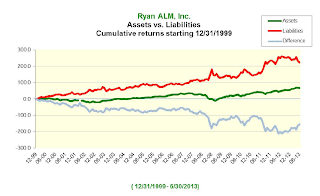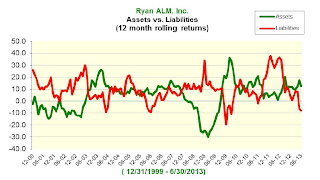For the full commentary you can go to John Kay's website (click here)In the modern financial economy, the main effect of QE is to boost asset prices, as market gyrations of recent weeks have clearly illustrated. But is the pursuit of higher asset prices an effective or desirable means of promoting economic growth? The distributional impact of the policy demands attention; the one certain consequence of boosting asset prices is that those with assets benefit relative to those without. Many people own houses – but, although in the UK, for example, we need more houses, we do not need another housing boom. The public also holds financial assets indirectly, largely through pension funds. But here there has been a paradoxical effect: because of the way pension funds are valued, QE has generally increased pension funds’ liabilities more than their assets.
The last sentence was a massive understatement from John Kay. See charts below for Canada and more so the United States which has embraced zero interest rate policy along with the Federal Reserve's own brand of quantitative easing. Growth in liabilities continues to outpace growth in assets leading to more DB (defined benefit) plans being underfunded. At the extreme, it may be the death knell for many if plan sponsors continue to cling to the belief that asset returns will mean revert to those seen during the bull market of the 1980s and 1990s along with a corresponding pop in nominal interest rates. As yours truly has asked many an investment consultant and actuary: "what about the Japan scenario? what then?"
 |
| Canadian Pension Funding: Cumulative Returns - Assets vs. Liabilities (2006 - 2013 YTD) |
 |
| U.S. Pension Funding: Cumulative Returns - Assets vs. Liabilities (2000 - 2013 YTD) |
 |
| U.S. Pension Funding: 12 Month Rolling Returns: Assets vs. Liabilities (2000 - 2013 YTD) |
Why has so much attention been given to these monetary policies with no clear explanation of how they might be expected to work and little evidence of effectiveness? The very phrase “quantitative easing” seems designed to discourage non-technical discussion. But the real answer, I fear, is all too familiar: these policies may not benefit the non-financial economy much, but they are helpful to the financial services sector and those who work in it.
Comment:
By now it should be clear that the incarnations of QE as executed by the FED, BOE, and ECB have not been as helpful as originally advertised. There is the old yarn spun by economists about lags in policy being long and variable: this has never been more true than in the case of QE where the lag has been longer than expected with the consequence of asset reflation rather than capital investment to grow the productive capacity of an economy.
The line of thinking from establishment circles places great emphasis on managing expectations and decreasing policy uncertainty. This is a canard. All actors in an economy live by heuristics, sometimes less rationally than others, but always with an implicit understanding that --with a bit of luck and a lot of hard work-- there should be a light at the end of the tunnel. It is this hope that drives capitalism and running the rat race on a knife edge that keeps people going; the finely worded proclamations of Chairman Bernanke, Governor Carney, President Draghi which are so closely watched, read and parsed by financial market actors are completely lost on the common person trying to make ends meet.
If QE is to work as a useful policy tool that ideally it should have the explicit goal of expanding credit creation in the productive economy --not providing more mortgage financing for real estate speculation. The banking sector plays a massive role in this regard and whether concepts of narrower banking and more localized banking are realistic or not will be the decision of national policy makers and regulators. One thing is unequivocal: a return to the 4 C's of credit --character, capacity, capital, collateral-- with a nod to the fifth C (conditions) is necessary to fund the business sector in general and SMEs in particular. This entails a less profitable banking sector but, perversely, a more productive, more dynamic and healthier economy than we have now.
References:
Kay, J. Financial Times, "Quantitative easing and the curious case of the leaky bucket." Last modified July 10, 2013. Accessed July 19, 2013. http://www.johnkay.com/2013/07/10/quantitative-easing-and-the-curious-case-of-the-leaky-bucket.
No comments:
Post a Comment